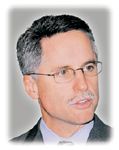Article
Older, sicker men receive ADT for localized prostate Ca
Orlando, FL--Men with localized prostate cancer who are treated with primary androgen deprivation therapy tend to be older and to have more comorbidities and lower incomes than men treated by other primary therapies, according to a study presented at the 2005 American Society of Clinical Oncology meeting.

Although the efficacy of primary hormonal therapy has been shown for metastatic prostate cancer, no study to date has demonstrated that androgen deprivation benefits survival in men with lower-stage disease, said study co-author Peter R. Carroll, MD, professor and chair, department of urology, University of California, San Francisco.
Dr. Carroll and his colleagues assessed the characteristics and survival rates of 7,045 patients diagnosed with localized disease between 1989 and 2002. Data were obtained from the Cancer of the Prostate Strategic Urologic Research Endeavor (CaPSURE) database, a longitudinal observational disease registry of men with prostate cancer from 31 currently enrolled urologic practices.
Compared with patients treated with other primary therapies, the study found that men treated with androgen deprivation tended to be older than 70 years (32% vs. 73%), to make less than $30,000 per year (33% vs. 55%), to have more high-risk characteristics (21% vs. 49%), and to have three or more comorbid conditions (26% vs. 42%).
The lower incomes of these patients may "reflect the fact that older patients are no longer working and have less income," said Dr. Carroll. They also may opt for primary androgen deprivation over other therapies because of increased risk of surgery and/or other curative therapies with advancing age and increasing comorbidities, he said.
Patients treated with androgen deprivation also tended to have higher-risk disease than those treated with other therapies, with significantly more patients undergoing androgen deprivation having a Gleason score >7 (51% vs. 29%, p<.01) and higher median PSA values (10.4 ng/mL vs. 6.6 ng/mL, p<.01).
Although most androgen deprivation-treated patients had higher-risk disease, 23% had low-risk features, Dr. Carroll said.
"This study cannot explain if these patients with low risk chose therapy because they wished to have something done or if watchful waiting/active surveillance was offered and [these patients] declined," he said.
"The side effects of androgen deprivation therapy should be well known both to patients and to their physicians before such therapy is offered to men. The morbidity may very well outweigh any benefit in men with lower stages/grades of disease."
Overall, 146 (14.7%) of the men receiving primary androgen therapy have died, 22 (2.2%) from prostate cancer.


